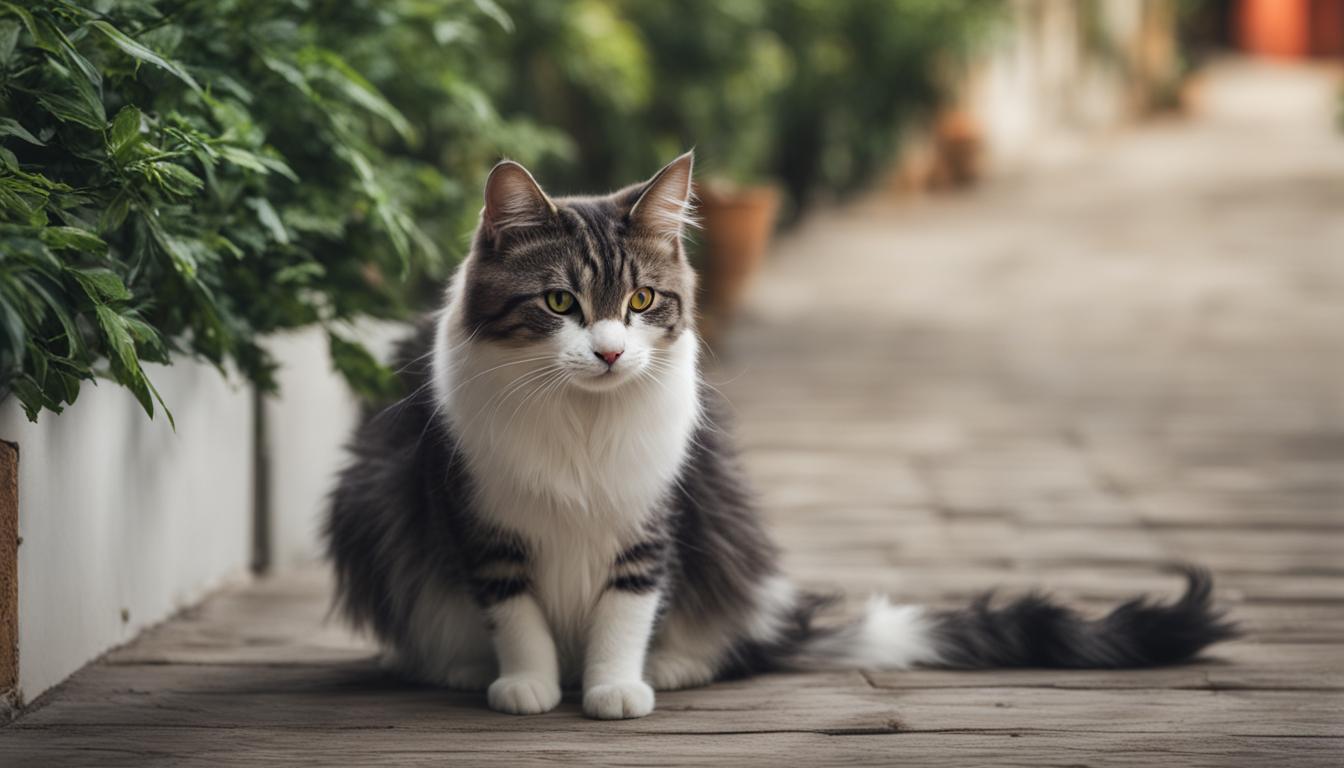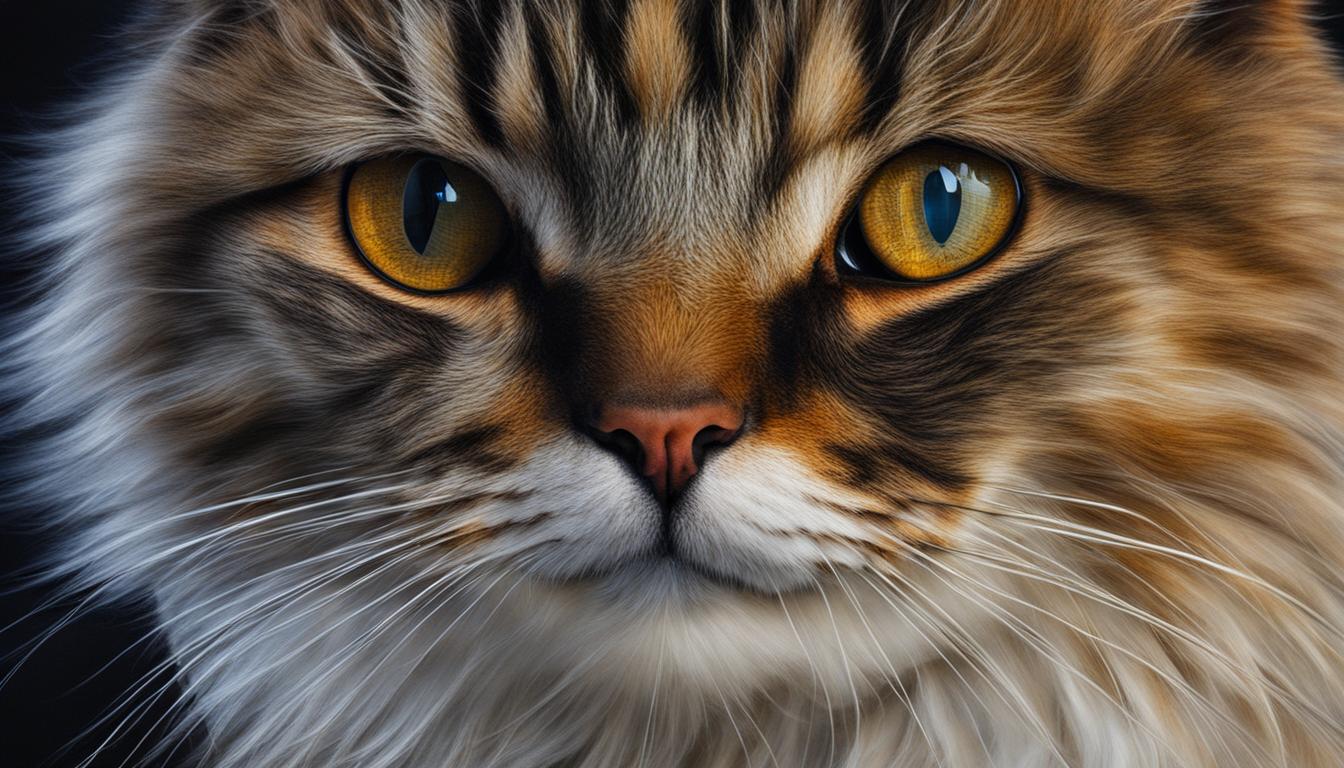As a cat owner, have you ever wondered what your furry friend’s purring really means? Is it a sign of happiness or something more? Join me as we delve into the fascinating world of cat purring and unravel the mysteries behind this unique feline behavior.
Cats are enigmatic creatures, often conveying their emotions through subtle cues. While purring is commonly associated with contentment, it can also serve as an indicator of stress or anxiety. By understanding the psychology behind cat purring, we can gain valuable insights into our cats’ well-being and provide them with the care they need.
Key Takeaways:
- Interpreting cat purrs is essential for understanding feline emotions and needs.
- Purring can indicate contentment, but it can also signal stress or discomfort.
- Cats may use purring to self-soothe in challenging situations.
- Understanding the different types of purring and their frequencies can help decipher their messages.
- Purring serves as a form of communication and bonding between cats and their owners.
Reasons Cats Purr When Petted
When it comes to petting cats, there’s something magical about the gentle vibrations that emanate from their furry bodies. Cats often purr when they are being petted, and this behavior serves as a fascinating insight into their emotional world. So, why do cats purr when they’re being petted?
First and foremost, purring is a sign of relaxation and contentment in cats. When you stroke your feline friend’s fur, it provides them with physical stimulation that they find pleasurable. Furthermore, this act of petting can release endorphins in the cat’s brain, contributing to their overall positive experience. The rhythmic purring serves as a way for cats to express their state of contentment and enjoyment.
Purring when being petted also serves as a bonding behavior. By purring, cats are expressing trust and affection towards their human companions. It’s their way of saying, “I feel safe and comfortable with you.” This mutual exchange of positive energy strengthens the bond between cats and their owners, creating a deeper connection.
It’s essential to observe your cat’s other body language and cues while they are purring during petting sessions. Although purring is generally a positive sign, it’s crucial to ensure that the cat is truly enjoying the interaction. Look out for relaxed body postures, gentle kneading, and a calm demeanor to confirm that your feline friend is experiencing pure bliss.
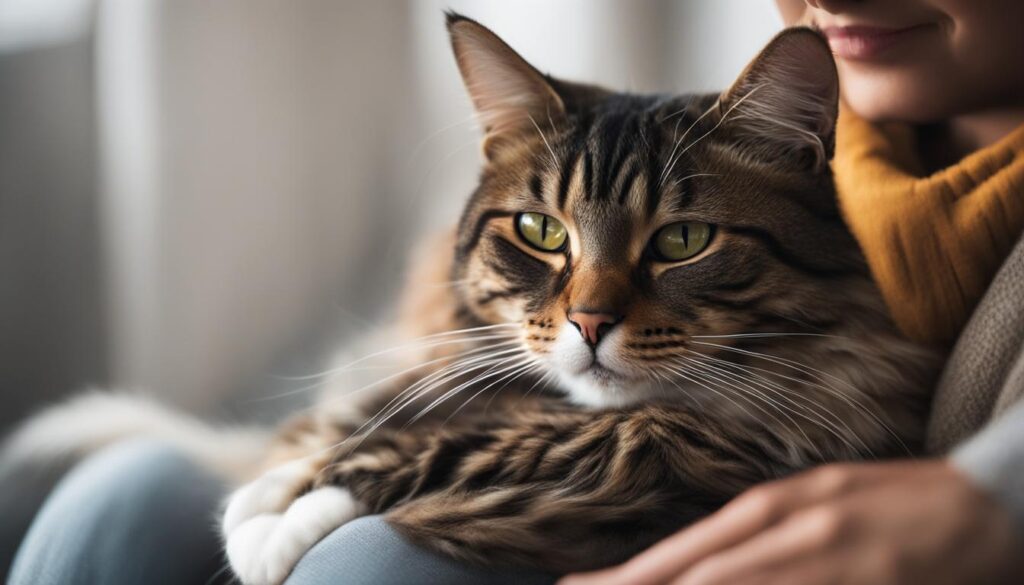
Benefits of Purring When Petted
“The gentle vibrations of a cat’s purr serve as a soothing therapy for both the cat and their human companion.”
The act of purring when being petted goes beyond emotional expression and bonding. It actually has several health benefits for both cats and humans. The gentle vibrations produced during purring can promote healing and reduce pain. It has been shown to have a positive impact on bone density, which is especially beneficial for older cats or those recovering from injuries or illnesses.
For humans, the calming effect of a cat’s purring can help relax the body and lower stress levels. It has even been associated with reduced blood pressure. The soothing sound of a contented cat can create a peaceful environment, providing comfort and relaxation for both cats and their human companions.
| Benefits of Purring When Petted | For Cats | For Humans |
|---|---|---|
| Promotes healing | ✓ | ✓ |
| Reduces pain | ✓ | ✓ |
| Improves bone density | ✓ | |
| Relaxes the body | ✓ | ✓ |
| Lowers stress levels | ✓ | ✓ |
| Reduces blood pressure | ✓ |
So, the next time you find yourself petting a purring cat, relish in the joy of this delightful experience. Not only are you providing comfort and happiness to your feline companion, but you’re also reaping the benefits of relaxation and stress reduction yourself. It’s a win-win situation that strengthens the bond between you and your furry friend.
Cat Purring Health Benefits
Did you know that cat purring goes beyond expressing contentment? It turns out that the vibrations produced during purring can have several health benefits, not just for cats but also for their human owners. Let’s explore these fascinating health benefits of cat purring.
The vibrations produced during purring can stimulate healing and reduce pain.
Cat purring has been found to have a positive impact on bone density. The low-frequency vibrations can help promote bone growth and prevent osteoporosis, making cats less prone to fractures and other bone-related issues.
Additionally, the act of purring promotes relaxation and lowers stress levels. The rhythmic sound and vibrations have a soothing effect on both cats and humans, helping to reduce anxiety and promote a sense of calm.
But that’s not all. Studies have also shown that cat purring can lower blood pressure. The gentle vibrations caused by purring can help dilate blood vessels, improving circulation and reducing the risk of cardiovascular problems.
Cat purring provides comfort and soothing effects for cats and aids in their recovery from injuries or illnesses.
Furthermore, purring can provide comfort and soothing effects for cats. It acts as a form of self-soothing, helping them cope with pain, stress, or anxiety. The vibrations and sound of purring release endorphins, natural painkillers that can alleviate discomfort and promote healing.
So, the next time your furry friend curls up beside you and starts purring, remember that their purr is not only a sign of contentment but also a source of potential health benefits for both of you.
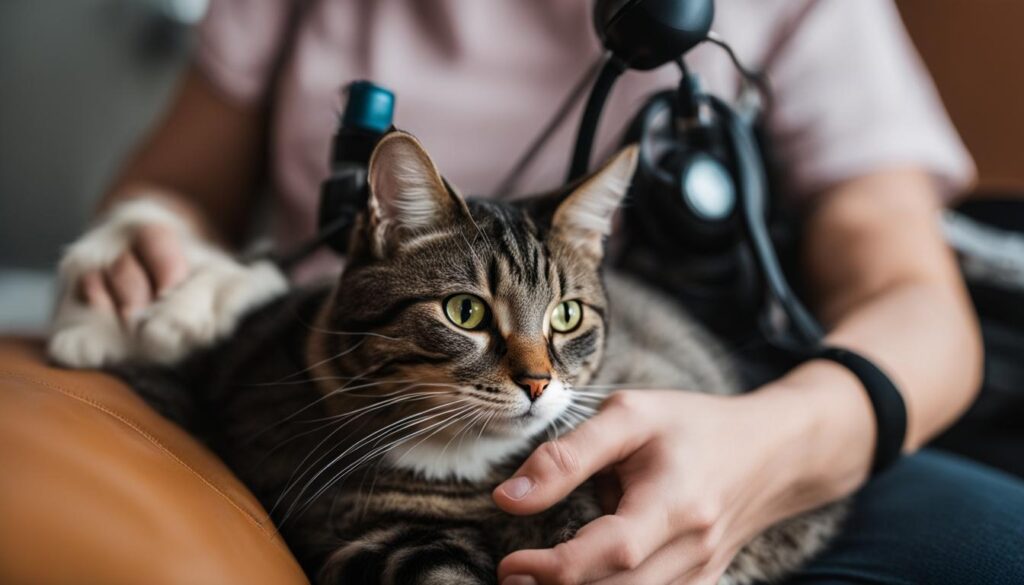
Table: Health Benefits of Cat Purring
| Health Benefit | Description |
|---|---|
| Pain Relief | The vibrations produced during purring can stimulate healing and reduce pain. |
| Bone Density | Purring has been linked to positive effects on bone density, promoting bone growth and preventing osteoporosis. |
| Relaxation | Purring promotes relaxation and lowers stress levels, providing a soothing effect for both cats and humans. |
| Blood Pressure | The vibrations caused by purring can lower blood pressure, improving circulation and reducing the risk of cardiovascular problems. |
| Comfort and Healing | Purring provides comfort and soothing effects for cats, aiding in their recovery from injuries or illnesses. |
Cat Purring Frequencies and Differences in Purring Sounds
When it comes to cat purring, frequencies and sounds can vary, providing valuable insights into a cat’s emotions and needs. The typical purr falls within a low-frequency range of 25 to 150 Hertz, but individual cats may have different purring frequencies within this range. Factors such as size, breed, and overall health can influence the frequency of a cat’s purring.
Cats also have the ability to produce variations in the sounds of their purring. Some cats may have softer purrs, while others may have louder purrs. These variations can convey their emotional state or the context of the situation. For example, a softer purr may indicate contentment and relaxation, while a louder purr may signal excitement or a desire for attention.
Understanding these differences in purring frequencies and sounds can enhance a cat owner’s ability to interpret their feline companion’s emotions and needs. By paying attention to the specific purring characteristics of their cat, such as the frequency and intensity, cat owners can better understand when their cat is happy, stressed, or in need of attention.

Table: Cat Purring Frequencies by Breed
| Breed | Purring Frequency (Hertz) |
|---|---|
| Maine Coon | 25-50 |
| Persian | 50-75 |
| Siamese | 75-100 |
| Scottish Fold | 100-125 |
| Sphynx | 125-150 |
Table: Cat purring frequencies by breed. Note that these ranges are approximate and can vary within each breed.
Cat Purring as a Stress Indicator
While purring is commonly associated with contentment, it can also serve as an indicator of stress or anxiety in cats. Purring is a natural self-soothing behavior that cats use to calm themselves in stressful or unfamiliar situations. It’s their way of seeking comfort and reassurance. So, if you notice your cat purring excessively or in situations where they might be feeling anxious, it’s important to pay attention to their behavior and provide them with a supportive environment.
Changes in purring patterns can also be a sign of underlying stress or discomfort. If your cat’s purring becomes more frequent or intense, it could indicate that they are experiencing heightened levels of stress. It’s crucial to observe their overall body language and other cues to understand the context of their purring. By doing so, you can better assess their emotional well-being and take necessary steps to alleviate their stress.
Creating a calm and soothing environment for your cat can help reduce their stress levels. Providing them with a designated safe space, enriching their environment with toys and interactive activities, and establishing a consistent routine can all contribute to their overall well-being. Additionally, engaging in regular playtime and interactive bonding activities with your cat can help strengthen your bond and provide them with the social interaction they need.
Cat Purring and Communication
Cats have a unique way of communicating with their owners, using purring as one of their primary methods of expression. Purring not only signifies contentment, but it also serves as a means for cats to communicate their needs, desires, and overall well-being. As a cat owner, it is important to pay attention to your feline friend’s purring and understand the message behind it.
When a cat purrs, it can be a way of getting your attention. Whether they want to be fed, let outside, or simply want some cuddle time, their purring serves as a gentle request for your assistance. Additionally, purring can indicate a cat’s overall sense of well-being. A steady, rhythmic purr often signifies contentment and happiness, while an urgent or high-pitched purr may indicate a specific desire or need.
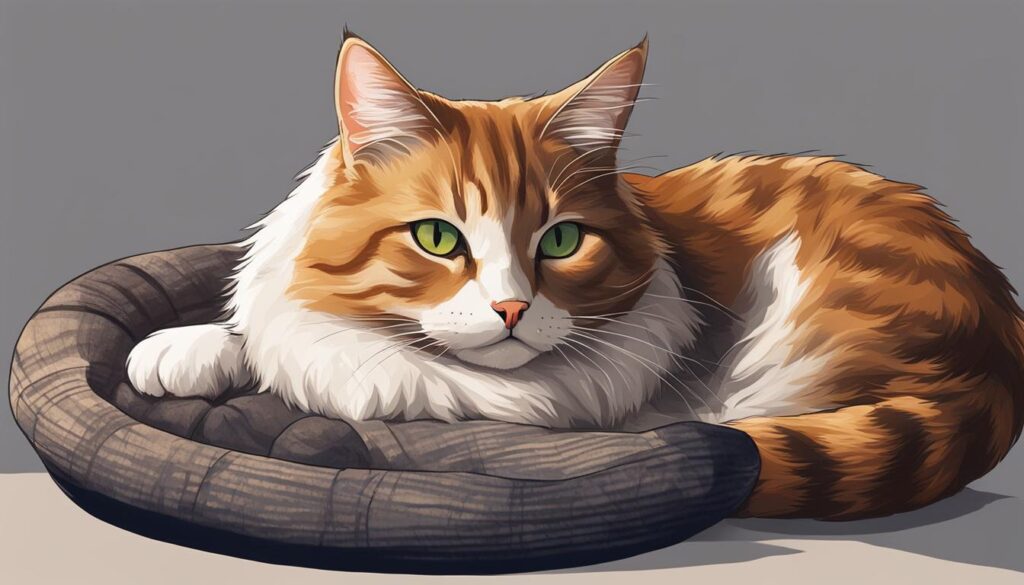
Understanding the context and accompanying body language is crucial when deciphering a cat’s purring. By paying attention to their facial expressions, tail movements, and overall demeanor, you can gain a deeper understanding of what they are trying to convey. For example, a cat purring while rubbing against your leg may be expressing affection and a desire for attention, while a cat purring with flattened ears and a tense body may be signaling stress or discomfort.
By actively listening and responding to your cat’s purring, you can foster effective communication and strengthen the bond between you and your furry companion. Remember, cats use purring as a means of expressing their emotions and needs, so take the time to decode their unique language and provide them with the care and attention they deserve.
Conclusion
So there you have it, the fascinating world of cat purring! As I delved into the intricacies of cat purrs, I discovered that they are not simply an expression of contentment, but a complex form of communication. Through their purring, cats can convey their emotions, bond with their human companions, and even provide health benefits.
Understanding cat purring psychology is the key to interpreting the messages behind those melodic vibrations. By paying attention to the different types of purring, frequencies, and accompanying body language, we can gain insights into our feline friends’ needs and tailor our care accordingly.
Moreover, cat purring serves as a powerful tool for strengthening the bond between cats and their owners. It allows cats to express their desires, communicate their overall well-being, and create a connection that goes beyond words.
So the next time you hear your furry friend purring, take a moment to listen and decode the hidden messages. It’s not just a simple sound; it’s the language of love and companionship, and a window into the world of our mysterious feline companions.
FAQ
What does a cat’s purring mean?
Cat purring can indicate contentment, relaxation, and happiness. However, it can also occur in situations of pain, stress, or anxiety.
Why do cats purr when being petted?
Cats often purr when being petted as a sign of relaxation, contentment, and bonding. It can also release endorphins, providing a positive experience for the cat.
Are there any health benefits to cat purring?
Yes, cat purring has been associated with promoting healing, reducing pain, lowering stress levels, improving bone density, and even lowering blood pressure.
Can cats have different frequencies of purring?
Yes, cats can produce purring sounds at varying frequencies within the typical range of 25 to 150 Hertz. Factors like size, breed, and health can influence the frequency of their purring.
Can cat purring indicate stress or anxiety?
Yes, cats may purr to self-soothe and comfort themselves in stressful or unfamiliar environments. Changes in purring patterns, such as an increase in frequency or intensity, can be a sign of underlying stress or discomfort.
How do cats use purring to communicate?
Cats use purring as a form of communication to get their owners’ attention, indicate their needs or desires, and express their overall well-being. It is important to pay attention to the context and accompanying body language to understand the message behind a cat’s purring.


